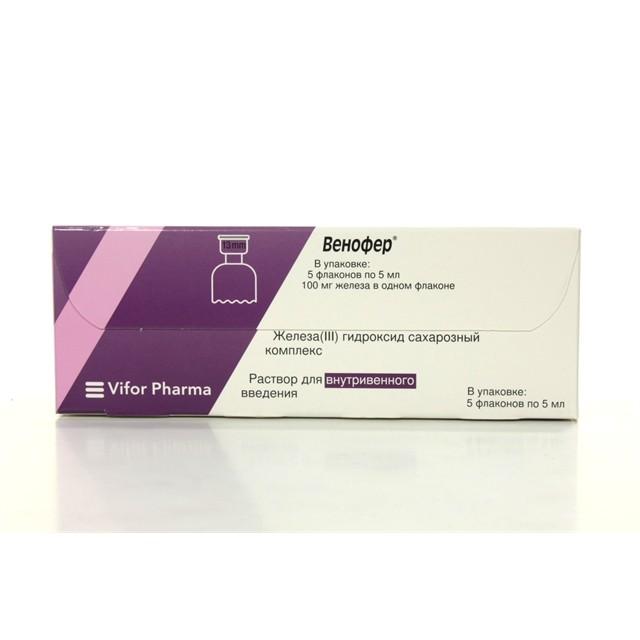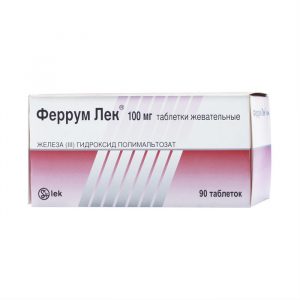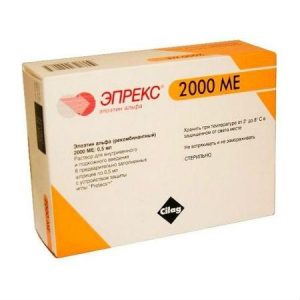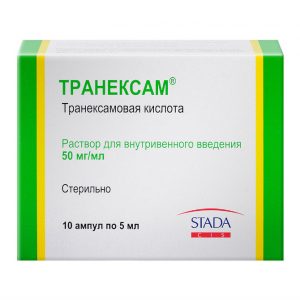Description
Release form
solution for intravenous administration
Packing
5 bottles of 5 ml.
Pharmacological action
Pharmacodynamics
The multinuclear centers of iron (III) hydroxide are surrounded externally by many non-covalently bound sucrose molecules. The result is a complex with a molecular weight of approximately 43 kD, as a result, its excretion through the kidneys in unchanged form is impossible.
This complex is stable and does not emit iron ions under physiological conditions. Iron in this complex is associated with structures similar to natural ferritin.
Pharmacokinetics of
After a single intravenous administration of Venofer containing 100 mg of iron, Cmax of iron, on average 538 mol, is reached 10 minutes after injection. Vd of the central chamber almost completely corresponds to the volume of serum (about 3 l).
T1 / 2 – about 6 hours. Vss is approximately 8 L (which indicates a low distribution of iron in body fluids). Due to the low stability of iron, sugar in comparison with transferrin, a competitive exchange of iron in favor of transferrin is observed. As a result, about 31 mg of iron is transferred in 24 hours.
The excretion of iron by the kidneys in the first 4 hours after injection is less than 5% of the total clearance. After 24 hours, the serum iron level returns to its original (before administration) value, and approximately 75% of sucrose leaves the vascular bed.
Indications
Iron deficiency conditions:
if fast iron supplementation is needed
with intolerance to oral iron preparations
in the presence of active inflammatory bowel diseases, when oral iron preparations are ineffective.
Contraindications
hypersensitivity to the drug Venofer or its components
signs of iron overload (hemosiderosis, hemochromatosis) or violation of its utilization
I trimester of pregnancy.
Precautions: bronchial asthma, eczema, polyvalent allergies, allergic reactions to other parenteral iron preparations, low serum iron binding capacity and / or folic acid deficiency, liver failure, acute or chronic infectious diseases (due to the fact that parenteral administration of iron may cause adverse effect in the presence of a bacterial or viral infection) and persons who have elevated serum ferritin levels.
Use during pregnancy and lactation
the patient has been shown to have had no experience the effects of iron sugar on the course of pregnancy and the health of the fetus / newborn.
To date, no well-controlled studies in pregnant women have been conducted.
Animal reproduction studies have not shown direct or indirect harmful effects on embryo / fetal development, childbirth or postnatal development.
However, further investigation of the risk / benefit ratio is required.
The release of unmetabolized iron sugar in breast milk is unlikely.
Thus, Venofer poses no risk to breast-fed infants.
Specific instructions
Venofer should be given only to those patients whose diagnosis of anemia is confirmed by appropriate laboratory data (for example, the results of determination of serum ferritin or hemoglobin and hematocrit, the number of red blood cells and their parameters – the average volume of the red blood cell, the average hemoglobin in the red blood cell).
Intravenous iron preparations can cause allergic or anaphylactoid reactions, which can be potentially life-threatening.
The Venofer administration rate should be strictly observed (blood pressure may decrease with rapid administration). A higher incidence of adverse side effects (in particular, a decrease in blood pressure), which can also be severe, is associated with an increase in dose. Thus, the time of administration of the drug given in the section “Method of use” should be strictly observed, even if the patient does not receive the drug in the maximum tolerated single dose.
Studies in patients with hypersensitivity reactions to iron dextran showed no complications during treatment with Venofer.
Avoid the penetration of the drug into the parietal space, as getting Venofer outside the vessel leads to tissue necrosis and brown staining of the skin. In the case of the development of this complication, in order to accelerate the excretion of iron and prevent its further penetration into the surrounding tissues, it is recommended that heparin-containing preparations be applied to the injection site (the gel or ointment is applied with light movements, without rubbing).
Expiration after the first opening of the container: from a microbiological point of view, the drug should be used immediately.
Expiration after dilution with saline: chemical and physical stability after dilution at room temperature is maintained for 12 hours. From a microbiological point of view, the solution should be used immediately. If the drug was not used immediately after dilution, the user is responsible for the conditions and storage time, which in any case should not exceed 3 hours at room temperature if the dilution was performed under controlled and guaranteed aseptic conditions.
Influence on the ability to drive a car and work with mechanisms. It is unlikely that Venofer may have an undesirable effect on the ability to drive a car and work with mechanisms.
Dosage and administration
Venofer is administered only intravenously – slowly in a stream or drip, and also into the venous section of the dialysis system – and is not intended for intramuscular administration. The simultaneous administration of a full therapeutic dose of the drug is unacceptable.
A test dose must be given before the first therapeutic dose. If intolerance phenomena occur during the observation period, the drug should be discontinued immediately. Before opening the ampoule, you need to inspect it for possible sediment and damage. You can use only brown solution without sediment.
Drip administration: Venofer is preferable to be administered during a drip infusion in order to reduce the risk of a pronounced decrease in blood pressure and the risk of the solution entering the parietal space. Immediately prior to infusion, Venofer should be diluted with a 0.9% sodium chloride solution in a ratio of 1:20, for example, 1 ml (20 mg of iron) in 20 ml of a 0.9% sodium chloride solution. The resulting solution is introduced at the following rate: 100 mg of iron – in not less than 15 minutes 200 mg of iron – within 30 minutes 300 mg of iron – within 1.5 hours 400 mg of iron – within 2.5 hours 500 mg of iron – within 3.5 hours. The introduction of a maximum tolerated single dose of 7 mg of iron / kg should be carried out for a minimum of 3.5 hours, regardless of the total dose of the drug.
Before the first drip of a therapeutic dose of Venofer, a test dose must be administered: 20 mg of iron for adults and children weighing more than 14 kg and half of the daily dose (1.5 mg of iron / kg) for children weighing less than 14 kg for 15 minutes In the absence of adverse events, the remainder of the solution should be administered at the recommended rate.
Inkjet administration: Venofer can also be administered as an undiluted solution intravenously slowly, at a rate (normal) of 1 ml of Venofer (20 mg of iron) per minute, i.e. 5 ml of the drug Venofer (100 mg of iron) is administered in at least 5 minutes. The maximum volume should not exceed 10 ml of Venofer (200 mg of iron) per 1 injection.
Before the first jet administration of a therapeutic dose of Venofer, a test dose should be prescribed: 1 ml of Venofer (20 mg of iron) for adults and children weighing more than 14 kg and half of the daily dose (1.5 mg of iron / kg) for children weighing less than 14 kg for 1-2 minutes. In the absence of adverse events during the next 15 minutes of observation, the remainder of the solution should be administered at the recommended rate. After the injection, the patient is recommended to fix the arm in an extended position for some time.
Introduction to the dialysis system: Venofer can be injected directly into the venous section of the dialysis system, strictly following the rules described for intravenous injection.
Dose calculation: the dose is calculated individually, in accordance with the total iron deficiency in the body according to the formula:
Total iron deficiency, mg = body weight, kg? (normal Hb level? patient’s Hb level), g / l? 0.24 * + deposited iron, mg.
For patients weighing less than 35 kg: normal level of Hb = 130 g / l, the amount of deposited iron = 15 mg / kg.
For patients weighing more than 35 kg: normal level of Hb = 150 g / l, the amount of deposited iron = 500 mg.
* Coefficient 0.24 = 0.0034? 0.07? 1000 (iron content in Hb = 0.34% blood volume = 7% of body weight coefficient 1000 = conversion from “g” to “mg”).
The total volume of the drug Venofer, which must be entered (in ml) = total iron deficiency (mg) / 20 mg / ml (see table).
table The total volume of the drug Venofer for the treatment of
body weight, 85 2340 117 2040 102 1720 86 1420 71
90 2440 122 2120 106 1800 90 1480 74
In the case when the total therapeutic dose exceeds the maximum permissible single dose, fractional administration of the drug is recommended.
If after 1-2 weeks after the start of treatment with Venofer, there is no improvement in hematological parameters, it is necessary to review the initial diagnosis.
Calculation of the dose to replenish the iron level after blood loss or autologous blood donation
The dose of Venofer is calculated according to the following formula:
– if the amount of blood lost is known: iv administration of 200 mg of iron (10 ml of Venofer) leads to the same increase in Hb concentration as well as transfusion of 1 unit of blood (400 ml with a concentration of Hb = 150 g / l).
Amount of iron, to be replenished (mg) = number of units of blood lost? 200
or
Required amount of Venofer (ml) = number of units of blood lost? 10.
– when lowering the level of Hb: use the previous formula, provided that the iron depot is not required to replenish.
Amount of iron to be replenished (mg) = body weight, kg? 0.24? (normal Hb level? patient’s Hb level), g / l.
For example: body weight 60 kg, deficiency Hb = 10 g / l required amount of iron 150 mg required volume of the drug Venofer = 7.5 ml.
Standard dosage
Adults and elderly patients: 5-10 ml Venofer (100-200 mg of iron) 1-3 times a week, depending on the level of hemoglobin.
Children: There is only limited data on the use of the drug in children under 3 years of age. The recommended dose for children of other age groups is not more than 0.15 ml (3 mg of iron) per kg of body weight 1-3 times a week, depending on the level of hemoglobin.
Maximum tolerated single dose
Adults and elderly patients:
– for jet administration: 10 ml of Venofer (200 mg of iron), the duration of administration is at least 10 minutes.
– for drip administration: depending on the indications, a single dose can reach 500 mg of iron. The maximum permissible single dose is 7 mg / kg and is administered 1 time per week, but it should not exceed 500 mg of iron.
Side effects
Currently, the following adverse events are known that are temporary and possibly causal to the administration of Venofer ®. All symptoms were observed very rarely (the incidence rate is less than 0.01% and greater than or equal to 0.001%).
From the nervous system: dizziness, headache, loss of consciousness, paresthesia.
From the CCC side: palpitations, tachycardia, decreased blood pressure, collaptoid states, a feeling of heat, flushing of the face, peripheral edema.
On the part of the respiratory system: bronchospasm, shortness of breath.
From the gastrointestinal tract: diffuse abdominal pain, epigastric pain, diarrhea, taste perversion, nausea, vomiting.
From the skin: erythema, itching, rash, pigmentation disorders, increased sweating.
From the musculoskeletal system: arthralgia, back pain, swelling of the joints, myalgia, pain in the limbs.
From the side of the immune system: allergic, anaphylactoid reactions, incl. swelling of the face, swelling of the larynx.
General disorders and reactions at the injection site: asthenia, chest pain, feeling of heaviness in the chest, weakness, pain and swelling at the injection site (especially with extravasal ingestion of the drug), malaise, pallor, fever, chills.
Drug Interactions
Venofer should not be administered concomitantly with iron dosage forms for oral administration, as Helps reduce iron absorption from the digestive tract. Treatment with oral iron preparations can be started no earlier than 5 days after the last injection.
Venofer can be mixed in a single syringe only with sterile saline. No other IV solutions and therapeutic agents are allowed to be added, since there is a risk of precipitation and / or other pharmaceutical interactions. Compatibility with containers made of materials other than glass, PE and PVC has not been studied.
Overdose
Overdose can cause acute iron overload, which is manifested by symptoms of hemosiderosis.
Treatment: It is recommended to use symptomatic agents and, if necessary, iron-binding agents (chelates), such as intravenously.
Storage Conditions
At 4 25 ° C. In original packaging (do not freeze).
Shelf life
3 years.
Active ingredient
Iron III hydroxide sucrose complex
Terms and conditions
prescription
Dosage form
infusion solution
Appointment
Appointment
Adults doctor’s prescription
Vifor (International) Inc., Switzerland




